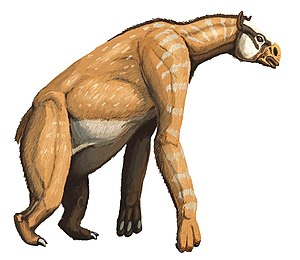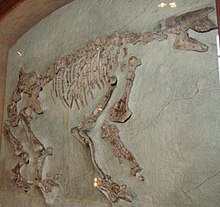Chalicotherium
| Chalicotherium | ||||||||||||
|---|---|---|---|---|---|---|---|---|---|---|---|---|

Live reconstruction of Chalicotherium |
||||||||||||
| Temporal occurrence | ||||||||||||
| Upper Oligocene to Lower Pliocene | ||||||||||||
| 16 to about 7.75 million years | ||||||||||||
| Locations | ||||||||||||
| Systematics | ||||||||||||
|
||||||||||||
| Scientific name | ||||||||||||
| Chalicotherium | ||||||||||||
| JJ Kaup , 1833 | ||||||||||||
| species | ||||||||||||
|
||||||||||||
Chalicotherium ( gr . Χαλιξ / Khalix , Khalik -: gravel + θηρίον / Therion , θηρ / ther : Animal), also claws animal called, is a genus of extinct Perissodactyla (Perissodactyla) from the family of chalicothere which from Upper Oligocene to the Lower Pliocene (16–7.75 million years ) lived in Europe , Africa and Asia for about 8.25 million years. The animals of the genus reached a shoulder height of 2.6 m and looked very much like other members of the Chalicotheria family, with long claw-reinforced forelimbs and shorter, weight-bearing hind limbs. The type species Chalicotherium goldfussi from the European Miocene and Pliocene was described in 1833 by the German paleontologist Johann Jakob Kaup (1803–1873). Since then, seven other species have been assigned to the genus. Chalicotheria areclosely relatedto tapirs and rhinos , with which they form the taxon Tapiromorpha .
features
At first glance , the animals appear to be a cross between a horse and a gorilla , with an equine head, long forelegs, and short hind legs. Like many unpaired ungulates, Chalicotherium was built for grazing, but among ungulate relatives it had a unique adaptation for this. Chalicotherium had a low, wide basin and could probably stand on two feet and use its long arms to pull high branches and twigs down to its short-faced head to get to the leaves. Thickening on the ischium , however, suggests that these animals sat on their buttocks for a long time, probably during grazing.
The horse-like head itself shows adaptations to a leaf-eating diet. The sexually mature animal has no incisors and upper canines , which suggests that the muscular lips and bare gums are sufficient to graze the food. The square, low-crowned molars show only minor signs of wear. This also indicates that Chalicotherium only consumed soft vegetation.
The large forefeet of Chalicotherium had curved claws which were bent inwards at right angles. Ossification on the back of the hand finger bones is interpreted as an indication that the Chalicotherium went on the knuckles , similar to what is known from chimpanzees and gorillas . This mode of locomotion, with the claws bent towards the wrists, would have prevented the animal from holding its claws down while walking and thus exposing them to increased wear and tear. The claws were probably used as a kind of collecting rake when foraging , but the animal could also use them as formidable defensive weapons. Chalicotherium's ankle gait meant that most of its weight was on its hind legs. With such a mode of locomotion, animals of the genus Chalicotherium were not fast runners.
All of these characteristics show some convergences with the giant sloths , gorillas and the giant panda, which also belong to the mammals but are not closely related .
Paleobiology

Chalicotherium used to be thought to roam in herds. The reason for assumption was the discovery site Devínska Nová Ves (today a district of Bratislava , Slovakia ), where more than 1500 bone remains of this animal species were discovered in a karst fissure , with at least 60 individuals being differentiated based on the remains of teeth. All finds were in the same geological sediment layer . Today it is assumed that there are probably many individual copies that fell into the same column. Presumably Chalicotherium was a loner, or lived in small groups. In Chalicotherium an obvious sexual dimorphism can be observed. The males with a shoulder height of 2.6 m were clearly superior to the females with only 1.8 m in size. This suggests that rival fights occurred between the males during the mating season.
Internal system
unnamed
| Chalicotherium |
|
|||||||||||||||||||||||||||||||||||||||||||||
|
|
literature
- Michael J. Benton : Paleontology of the vertebrates. Translation of the 3rd English edition by Hans-Ulrich Pfretzschner. Publishing house Dr. Friedrich Pfeil, Munich 2007, ISBN 978-3-89937-072-0 , pp. 369-370.
- Tim Haines , Paul Chambers: Dinosaurs. Giants of the primeval world. Translated from the English by Axel Kwet. Franckh-Kosmos, Stuttgart 2007, ISBN 978-3-440-10961-8 , p. 177.
Web links
- Chalicotherium . The Paleobiology Database
Individual evidence
- ^ Donald R. Prothero, RM Schoch: Classification of the Perissodactyla. In: Donald R. Prothero, RM Schoch (Ed.): The evolution of perissodactyls. Oxford University Press, New York 1989, pp. 530-537.
- ↑ David J. Froehlich: Phylogenetic systematics of basal perissodactyls. In: Journal of Vertebrate Paleontology , 19 (1), 1999, pp. 140-159.
- ↑ Helmuth Zapfe : Ancylotherium in the Upper Miocene of the Vienna Basin. In: Annals of the Natural History Museum Vienna. 71, 1967, pp. 401-411.


